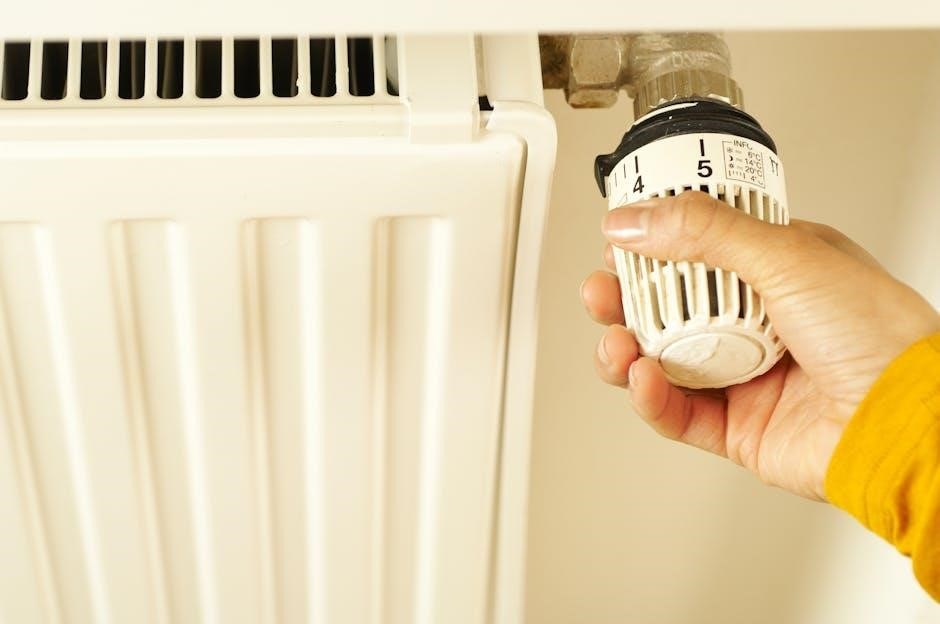totaline thermostat manual
Welcome to the Totaline Thermostat Manual. This guide provides essential information for installing‚ operating‚ and maintaining your programmable‚ non-programmable‚ or smart thermostat. Ensure optimal performance‚ energy efficiency‚ and comfort by following the instructions carefully. Read safety precautions and compatibility details before starting.
1.1 Overview of Totaline Thermostats
Totaline thermostats are versatile‚ wall-mounted‚ low-voltage devices designed to regulate HVAC systems efficiently. Available in programmable‚ non-programmable‚ and smart models‚ they cater to diverse user needs. Programmable models allow time period programming‚ optimizing temperature settings throughout the day. Smart thermostats offer advanced features like remote control and adaptive learning. Non-programmable options provide straightforward operation for simplicity. All models feature mode indicators for heat‚ cool‚ and fan settings‚ ensuring clear operation. Designed for compatibility with various HVAC systems‚ Totaline thermostats blend functionality‚ energy efficiency‚ and ease of use‚ making them a reliable choice for home comfort control.
1.2 Importance of Reading the Manual

Reading the Totaline thermostat manual is crucial for safe and effective installation‚ operation‚ and maintenance. It provides essential instructions to prevent equipment damage and ensures optimal performance. The manual outlines safety precautions‚ such as avoiding cooling system operation below 50°F to prevent compressor damage. It also guides users through advanced setup options and troubleshooting common issues. By understanding the manual‚ users can unlock all features‚ including programmable schedules and smart functionalities. Proper setup ensures energy efficiency‚ comfort‚ and extends the lifespan of your HVAC system. Always refer to the manual before making adjustments or repairs.

Types of Totaline Thermostats
Totaline offers programmable‚ non-programmable digital‚ and smart thermostats. Each type caters to different user needs‚ ensuring precise temperature control and energy efficiency for optimal comfort.
2.1 Programmable Thermostats
Programmable thermostats by Totaline allow users to pre-set temperature schedules‚ optimizing comfort and energy savings. These thermostats can run time period programming‚ adjusting heat and cool setpoints automatically based on the time of day. They are wall-mounted‚ low-voltage devices designed to maintain consistent temperatures by controlling HVAC systems. Features include advanced setup options‚ configurable output jumpers‚ and compatibility with various heating and cooling systems. Programmable models are ideal for users seeking precise control and energy efficiency‚ ensuring customized comfort throughout the day.
2.2 Non-Programmable Digital Thermostats

Totaline’s non-programmable digital thermostats offer simplicity and ease of use for basic temperature control. These thermostats allow manual adjustments of heat and cool settings without pre-set schedules. Designed for straightforward operation‚ they feature a digital display and compatibility with various HVAC systems. Ideal for users who prefer direct control‚ these models ensure reliable performance and energy efficiency. Installation is quick‚ and they operate in manual or auto-changeover modes‚ providing flexibility for different heating and cooling needs without the complexity of programming.
2.3 Smart Thermostats
Totaline smart thermostats combine advanced technology with energy efficiency‚ offering remote control via smartphones or voice assistants. These models integrate seamlessly with home automation systems‚ allowing users to adjust settings‚ monitor energy usage‚ and receive alerts. Features like geofencing and adaptive learning optimize heating and cooling based on occupancy and preferences. Compatible with various HVAC systems‚ they ensure precise temperature control and enhanced comfort. Installation is streamlined‚ and their intuitive interfaces make navigation easy‚ providing a modern solution for smart home enthusiasts.

Installation and Setup
Ensure power is off before starting. Mount the thermostat‚ connect wires‚ and follow the step-by-step guide for a secure setup. Refer to the manual for specific instructions.
3.1 Pre-Installation Checklist
Before installing your Totaline thermostat‚ ensure the system is compatible with your HVAC equipment. Verify the power requirements and wiring configuration. Turn off the power supply to the HVAC system at the circuit breaker. Gather necessary tools and materials. Check the thermostat’s packaging for any damage. Familiarize yourself with the installation manual. Ensure the wall mounting location is level and clear of obstacles. Confirm the thermostat type matches your heating and cooling system specifications. Prepare for any additional features like humidity control or smart functionality.
3.2 Step-by-Step Installation Guide
Turn off the power to your HVAC system at the circuit breaker.
Remove the old thermostat and label the wires for identification.
Mount the new thermostat base to the wall‚ ensuring it is level.
Connect the wires to the appropriate terminals‚ matching the labels.
Secure the thermostat faceplate to the base.
Turn the power back on and test the system.
Program the thermostat according to your preferences.
Dispose of the old thermostat responsibly;
3.3 Wiring and Connections
Ensure all wiring matches the terminal labels from your old thermostat. Connect the R (red) wire to the R terminal for power. The W (white) wire connects to W for heating‚ and Y (yellow) to Y for cooling. If you have a dual-fuel system‚ connect the O/B wire. Use the C (common) wire for the thermostat’s power return. Secure all connections tightly and avoid short circuits. Refer to the wiring diagram in the manual for specific configurations. Double-check connections before powering up the system to prevent damage or malfunctions.
3.4 Post-Installation Checks
After installation‚ turn the power back on and ensure the thermostat is set to OFF. Verify all wiring connections are secure and correct. Test the thermostat by switching modes (HEAT/COOL) and adjusting the temperature to confirm the HVAC system responds. Check for any error codes or unusual behavior. Ensure the display is clear and functional. Verify the time and date are correctly set if applicable. Test the fan operation and auto-changeover feature if equipped. Finally‚ confirm that the thermostat is level on the wall for accurate temperature sensing. If issues arise‚ consult the manual or contact a professional.

Features and Functionalities
Totaline thermostats offer advanced features like programmable scheduling‚ dehumidify and reheat modes‚ and mode indicators for heat‚ cool‚ and fan operations. They ensure precise temperature control‚ energy efficiency‚ and seamless integration with HVAC systems‚ providing comfort and convenience for users.
4.1 Basic Operating Instructions
Start by turning off the thermostat before adjusting settings. Use the touch-sensitive buttons or pull-out section for easy access. Set your desired temperature using the up or down arrows. Select modes like HEAT‚ COOL‚ or FAN using the mode button. Adjust the fan speed if available. Ensure the thermostat is set to AUTO for automatic operation. Refer to the pull-out instructions for quick guidance. Always follow safety precautions‚ such as not operating cooling below 50°F (10°C). This ensures optimal performance and prevents potential damage to your HVAC system.
4.2 Advanced Features (Dehumidify‚ Reheat‚ etc.)
Advanced features on Totaline thermostats enhance comfort and efficiency. The Dehumidify mode reduces humidity levels without overcooling‚ optimizing energy use. Reheat functionality works with cooling systems to prevent condensation and ensure consistent temperatures. These features are accessed via the setup menu‚ allowing customization to suit your needs. Programmable schedules and fan speed control further refine your system’s operation. Explore these settings to maximize your HVAC system’s performance and comfort.
4.3 Mode Indicators (Heat‚ Cool‚ etc.)
Totaline thermostats feature mode indicators to show the active operation mode. The HEAT mode indicator lights up when the heating system is engaged‚ while the COOL indicator activates during cooling. Additional modes include FAN (continuous or automatic) and OFF. Some models offer an Auto-Changeover mode‚ automatically switching between heating and cooling based on room temperature. These indicators provide clear visual feedback‚ ensuring users understand the system’s current operation. Refer to the display symbols or LEDs to monitor the active mode and adjust settings as needed for optimal comfort.

Programming the Thermostat
Program your Totaline thermostat to adjust heat and cool setpoints based on time periods. Set schedules for optimal comfort and energy efficiency‚ customizing temperature preferences for different times of day.
5.1 Time Period Programming
Time Period Programming allows your Totaline thermostat to automatically adjust heat and cool setpoints based on the time of day. This feature ensures energy efficiency by aligning temperature settings with your daily schedule. For example‚ you can set a lower temperature while sleeping or higher when you’re away. The thermostat comes preprogrammed with default settings‚ but you can customize them to suit your preferences. Use the menu to create time periods‚ such as waking up‚ leaving home‚ or returning‚ and assign specific temperatures for each. Refer to the Advanced Setup section for detailed customization options. Proper programming ensures optimal comfort and energy savings year-round.
5.2 Setting Up Schedules
Setting up schedules on your Totaline thermostat allows you to predefine temperature settings for different times of the day or week. For instance‚ you can create a weekday schedule with specific settings for morning‚ afternoon‚ evening‚ and night. Weekend schedules can be tailored separately for more flexibility. Use the menu to select the desired time periods and assign heat and cool setpoints. This feature ensures consistent comfort while optimizing energy usage. Regularly review and update your schedules to adapt to seasonal changes or lifestyle adjustments. Proper scheduling enhances efficiency and convenience‚ making it easier to manage your home’s climate year-round.
5.3 Adjusting Heat and Cool Setpoints
Adjusting heat and cool setpoints on your Totaline thermostat allows precise temperature control. Use the up and down arrows to increase or decrease the desired temperature. For heat mode‚ set the temperature between 40°F and 90°F‚ and for cool mode‚ between 50°F and 99°F. Ensure the thermostat is in the correct mode (Heat‚ Cool‚ or Auto) before making adjustments. The display will show the current setpoint‚ and changes will take effect immediately. Regularly adjusting setpoints helps optimize energy usage and maintain comfort. Always verify the temperature range suits your system’s capabilities for reliable operation.

Technical Specifications
Totaline thermostats feature a temperature range of 40°F to 90°F for heating and 50°F to 99°F for cooling. They operate on low voltage and are compatible with most HVAC systems‚ ensuring reliable performance and energy efficiency.
6.1 Temperature Range and Precision
Totaline thermostats maintain consistent temperature control with a range of 40°F to 90°F for heating and 50°F to 99°F for cooling. The precision allows for ±1°F accuracy‚ ensuring your home stays comfortable. These settings are factory-preset but can be adjusted to suit personal preferences. The thermostat’s ability to hold tight temperature ranges minimizes fluctuations‚ optimizing energy use and system performance. Proper calibration ensures accuracy‚ so refer to the manual for adjustment instructions if needed.
6.2 Power Requirements
Totaline thermostats typically require a 24V AC power supply‚ ensuring low-voltage operation. Some models may use battery power‚ while others are hardwired. Always verify the specific power requirements in your thermostat’s manual. Proper power setup is crucial for safe and efficient operation. Never attempt installation without disconnecting the power source to avoid potential electrical hazards. Adhering to these guidelines ensures optimal performance and longevity of your Totaline thermostat.
6.3 Compatibility with HVAC Systems
Totaline thermostats are designed to work seamlessly with a variety of HVAC systems‚ including single-stage‚ two-stage‚ and heat pump configurations. They are also compatible with gas furnaces and electric heating systems. Certain models may require specific wiring or setup adjustments for optimal performance with your HVAC equipment. Always refer to your thermostat’s manual to ensure compatibility and proper configuration. Some thermostats may need additional settings for systems like humidity control or dual-fuel setups. Proper installation ensures safe and efficient operation of your HVAC system.

Manual Setup and Factory Defaults
Access the setup menu to configure thermostat settings or restore factory defaults. Follow instructions carefully to ensure proper configuration for your HVAC system. Programmable models may require additional steps for features like electric heat or humidity control. Always turn off the thermostat before making changes to avoid system damage.
7.1 Accessing the Setup Menu
To access the setup menu on your Totaline thermostat‚ press and hold the menu button until “Setup” appears on the display. Use the navigation arrows to scroll through options like temperature settings‚ mode preferences‚ and advanced features. For programmable models‚ select “Advanced Setup” to customize schedules or system configurations. Ensure the thermostat is in “Off” mode before making changes to avoid system damage. Refer to the manual for specific instructions tailored to your model‚ such as the P374-2100 or P710U-21NHP‚ to navigate seamlessly through the setup process.
7.2 Restoring Factory Default Settings
Restoring factory defaults resets your Totaline thermostat to its original settings. Press and hold the “Menu” and “Down” buttons for 5 seconds. A confirmation message will appear; select “OK” to proceed. This action erases all custom settings‚ including schedules and preferences‚ returning the device to its initial configuration. Ensure the thermostat is in “Off” mode before performing this operation to prevent system damage. After restoration‚ restart the thermostat and reconfigure necessary settings. This feature is useful for troubleshooting or preparing the device for a new installation‚ as detailed in the manual.

Troubleshooting Common Issues
Identify and resolve common issues with your Totaline thermostat‚ such as display malfunctions‚ temperature inaccuracies‚ or system connectivity problems. Follow diagnostic steps and solutions outlined in the manual to ensure optimal performance and address errors effectively‚ minimizing downtime and maintaining comfort.
8.1 Common Problems and Solutions
Addressing common issues with your Totaline thermostat ensures smooth operation. If the display is blank‚ check power connections. For temperature inaccuracies‚ recalibrate the thermostat. If the system fails to respond‚ verify wiring connections and ensure the correct mode is selected. For recurring errors‚ refer to the error code list in the manual for specific solutions. Regularly cleaning the thermostat and updating settings can prevent many issues. Always follow safety guidelines to avoid equipment damage. Consult the troubleshooting section for detailed step-by-step solutions to restore functionality and comfort efficiently.
8.2 Error Codes and Their Meanings
Understanding error codes is crucial for resolving issues with your Totaline thermostat. Common codes include E1 (temperature difference exceeding setpoint range)‚ E2 (sensor malfunction)‚ and E3 (power issues). Refer to the manual for a comprehensive list of codes. Each code provides insights into the specific problem‚ such as faulty wiring‚ sensor damage‚ or system communication errors. Addressing these issues promptly ensures optimal performance and prevents further complications. Always consult the troubleshooting guide for detailed solutions and restart the system after corrections.
8.3 Maintenance Tips
Regular maintenance ensures your Totaline thermostat operates efficiently. Clean the thermostat face and sensors to avoid dust buildup. Replace batteries annually in battery-powered models. Check wiring connections for damage or corrosion. Update smart thermostats with the latest software for optimal performance. Schedule annual HVAC system checks by a professional. Ensure proper thermostat installation to prevent accuracy issues. Refer to the manual for reset procedures after power outages. Addressing minor issues promptly prevents major malfunctions‚ ensuring consistent heating and cooling performance throughout the year.
This manual provides comprehensive guidance for understanding and maintaining your Totaline thermostat. By following the instructions‚ you can ensure optimal performance‚ energy efficiency‚ and comfort. Refer to it regularly for troubleshooting and setup tips.
9.1 Summary of Key Features
Totaline thermostats offer advanced features like programmable scheduling‚ smart home integration‚ and energy-saving modes. They support various HVAC systems‚ including heat pumps and two-stage systems. Key functionalities include time period programming‚ mode indicators for heat and cool operations‚ and maintenance alerts. Smart thermostats provide remote access and adaptive learning. Non-programmable models offer simplicity with manual controls; All models ensure precise temperature control‚ compatibility with low-voltage systems‚ and user-friendly interfaces. These features enhance comfort‚ efficiency‚ and convenience‚ making Totaline thermostats a reliable choice for modern homes.
9.2 Final Tips for Effective Use
To maximize efficiency and convenience‚ always follow the manufacturer’s guidelines for installation and operation. Regularly update smart thermostats for optimal performance and security. Adjust temperature setpoints seasonally to save energy. For programmable models‚ ensure schedules align with daily routines. Perform routine maintenance‚ like cleaning sensors‚ to maintain accuracy. Double-check wiring connections during installation to avoid malfunctions. Use the programmable features to optimize energy usage and comfort. By adhering to these tips‚ you’ll enjoy enhanced comfort‚ energy savings‚ and prolonged thermostat longevity.

